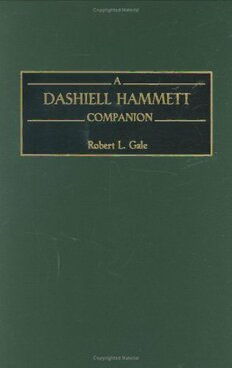
A Dashiell Hammett Companion PDF
Preview A Dashiell Hammett Companion
A DASHIELL HAMMETT COMPANION A DASHIELL HAMMETT COMPANION Robert L. Gale Greenwood Press Westport, Connecticut • London LibraryofCongressCataloging-in-PublicationData Gale,RobertL.,1919– ADashiellHammettcompanion/RobertL.Gale. p. cm. Includesbibliographicalreferencesandindex. ISBN0–313–31095–5(alk.paper) 1. Hammett,Dashiell,1894–1961—Encyclopedias. 2. Authors,American—20th century—Biography—Encyclopedias. 3. Detectiveandmysterystories, American—Encyclopedias. I. Title. PS3515.A4347 Z459 2000 813'.52—dc21 [B] 99–046037 BritishLibraryCataloguinginPublicationDataisavailable. Copyright(cid:2)2000byRobertL.Gale Allrightsreserved.Noportionofthisbookmaybe reproduced,byanyprocessortechnique,withoutthe expresswrittenconsentofthepublisher. LibraryofCongressCatalogCardNumber:99–046037 ISBN:0–313–31095–5 Firstpublishedin2000 GreenwoodPress,88PostRoadWest,Westport,CT06881 AnimprintofGreenwoodPublishingGroup,Inc. www.greenwood.com PrintedintheUnitedStatesofAmerica TM Thepaperusedinthisbookcomplieswiththe PermanentPaperStandardissuedbytheNational InformationStandardsOrganization(Z39.48–1984). 10 9 8 7 6 5 4 3 2 1 To agents of the U.S. Army Counter-Intelligence Corps active in World War II— We gumshoed in all theaters of the conflict in ways Dashiell Hammett would surely have admired Contents Preface ix Chronology xiii Abbreviations xvii Entries 1 General Bibliography 289 Index 291 Preface The story of Dashiell Hammett is one of the most curious in the annals of American literary history. The short span of his active writing career began with the publication of “The Parthian Shot,” a tiny short story in The Smart Set in 1922, and virtually ended when he published three excellent stories—“Two Sharp Knives,” “His Brother’s Keeper,” and es- pecially “This Little Pig”—in Collier’s in 1934. During this period, Ham- mett published sixty short stories, five novels—including The Maltese Falcon and The Thin Man—a few poems of no importance, some non- fictional prose pieces interesting for their autobiographical touches, and aquickspateofastutebookreviews.Hisfirstnovel,RedHarvest,depicts American corruption in a sharp focus he never essentially altered. The clevernessofsuchlateshortstoriesas“AlbertPastoratHome”and“Night Shade” indicates that he suffered no diminution of talent although he was about to turn inactive. After 1934, Hammett survived for another quarter of a century; how- ever, he wrote little, outlived his talent, and suffered from alcoholism, tuberculosis, and the sick effects of careless womanizing. He once criti- cized himself for “laziness, drunkenness, and illness.” His influence on other writers, however, and on writers for the moviesandtelevision,has survived to this day. Above all others, including Raymond Chandler, “Ellery Queen,” and James M. Cain, Hammett towers as the artist primarily responsible for the fast-track development of the American hard-boiled detective novel and short story. Chandler wrote in The Simple Art of Murder that “Ham- mett gave murder back to the kind of people that commit it for reasons, not just to provide a corpse; and with the means at hand, not hand- wrought dueling pistols, curare, and tropical fish. He put these people down on paper as they were, and he made them talk and think in the x PREFACE language they customarily used for these purposes....He wrote scenes that seemed never to have been written before.” Hammett has a secure place in American culture for elevatingmeretri- cious pulp fiction to the level of slick fiction and then to that of fiction respected by middle-highbrow readers eager to follow the well-crafted melodramatic action of real-life characters, often spattered by life. Ham- mett’s most unforgettable character is not Sam Spade, despite his being popularized by Humphrey Bogart’s superb rendition in John Huston’s 1941 film noir based on The Maltese Falcon. Hammett’s premier char- acter is surely the Continental Op, narrator and hero of the novels Red Harvest and The Dain Curse, and some twenty-seven short stories. The Op,asthisout-of-shapebuttough,stoical,andunnamedprivatedetective is called, typically enters a scene and cleans it up according to his own hard-to-define moral code. He cheerfully uses others, often innocent, to solve his assignments; and at the climax one wonders how clean the survivors are—or will remain. This is because Hammett, like his Opera- tive, had a bleak world view. If it was more stormy than sunshiny in the 1920s, when he first expressed it, how much more apt is it now that the next millennium has slouched into our ken? His fiction in the 1920s did not roar, it snarled. His West in the 1920s was not that of the popular oatersthen,whentheirheroescould“GoWest”andberegenerated.The Big Crash and the Great Depression threw their gloom and doom over Hammett’s dramatis personae both before 1929 and on into the 1930s. A possible blur in Hammett’s bleak world view lies in his portrayal of women. They are usually suspect when sleazy, and even more oftensus- pect when sexy. An element surprising to some readers is his inclusion of 1920s White Russians in his fiction. Hammett came by his knowledge of crime and criminal argot in the School of Hard Knocks. He had a difficult childhood, domineered by an unpleasant father, left school earlier than he probably would have liked, held a variety of jobs, and became a Pinkerton detective and then a sol- dier. Hollywood and easy money spoiled him, but not completely—he often violated his contracts, ran off with his advances, and spent with an abandon best defined as idiotic and self-destructive. If, as someoneonce said, a good writer needs an itch to scratch, Hammett suffered most of his life from psychological gleet. He piled up an imposing list of friends and acquaintances. Not the least of them were Fatty Arbuckle,* Gary Cooper, William Faulkner, Ben Hecht,* Ernest Hemingway,* Lillian Hellman,* Alfred A. Knopf,* Patricia Neal, Dorothy Parker,* Hunt Stromberg, and NathanaelWest.*(Asterisks indicate the existence of separate entries in this volume.) But sooner or later he ignored, insulted, or otherwise lost most of them. I hope that A Dashiell Hammett Companion, which is designed as a handy reference volume, will tempt the casual reader to make or renew an acquaintance with Hammett’s work. I also hope that it will enable
